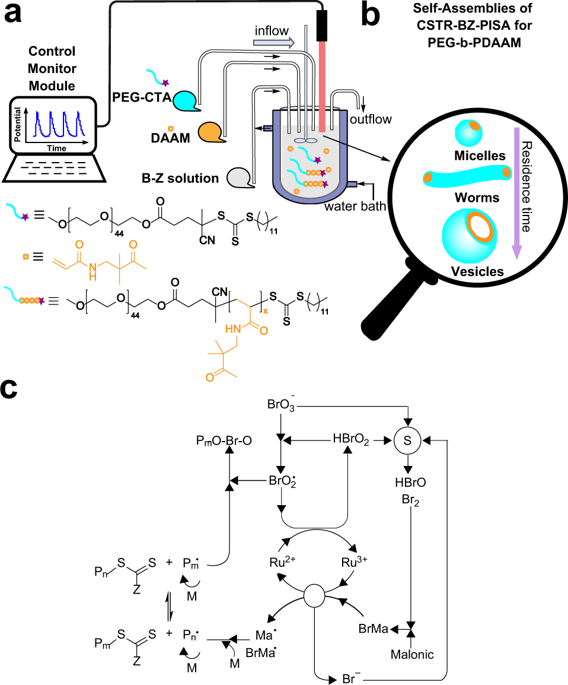Communications Chemistry ( IF 5.9 ) Pub Date : 2019-12-09 , DOI: 10.1038/s42004-019-0241-1 Liman Hou , Marta Dueñas-Díez , Rohit Srivastava , Juan Pérez-Mercader

|
Amphiphilic block-copolymer vesicles are increasingly used for medical and chemical applications, and a novel method for their transient self-assembly orchestrated by periodically generated radicals during the oscillatory Belousov-Zhabotinsky (BZ) reaction was recently developed. Here we report how combining this one pot polymerization-induced self-assembly (PISA) method with a continuously stirred tank reactor (CSTR) strategy allows for continuous and reproducible control of both the PISA process and the chemical features (e.g. the radical generation and oscillation) of the entrapped cargo. By appropriately tuning the residence time (τ), target degree of polymerization (DP) and the BZ reactants, intermediate self-assembly structures are also obtained (micelles, worms and nano-sized vesicles). Simultaneously, the chemical properties of the cargo at encapsulation are known and tunable, a key advantage over batch operation. Finally, we also show that BZ-driven polymerization in CSTR additionally supports more non-periodic dynamics such as bursting.
中文翻译:

流动化学控制Belousov-Zhabotinsky驱动的聚合诱导的自组装中的自组装和货物
两亲性嵌段共聚物囊泡越来越多地用于医学和化学应用,并且最近开发了一种新颖的方法,用于在振荡的Belousov-Zhabotinsky(BZ)反应过程中通过周期性生成的自由基精心安排它们的瞬时自组装。在这里,我们报告如何将这种一锅聚合诱发的自组装(PISA)方法与连续搅拌釜式反应器(CSTR)策略结合使用,从而可以对PISA工艺和化学特征(例如自由基的产生和振荡)进行连续且可重现的控制)被包裹的货物。通过适当调节停留时间(τ),目标聚合度(DP)和BZ反应物,还可以获得中间自组装结构(胶束,蠕虫和纳米大小的囊泡)。同时,封装时货物的化学性质是已知的且可调整的,这是与批生产相比的主要优势。最后,我们还表明,CSTR中BZ驱动的聚合还支持更多的非周期性动力学,例如爆裂。











































 京公网安备 11010802027423号
京公网安备 11010802027423号